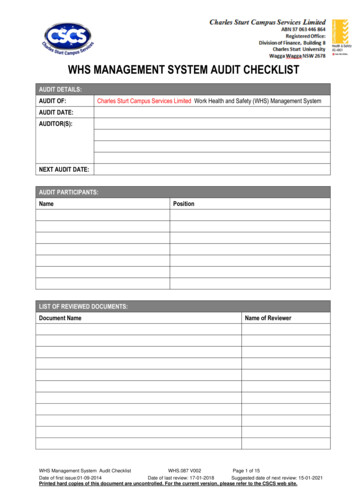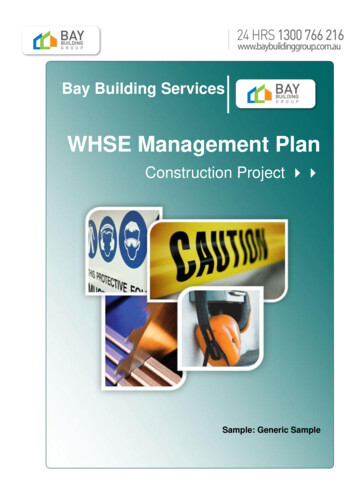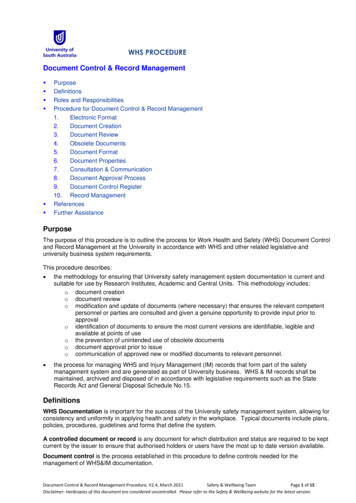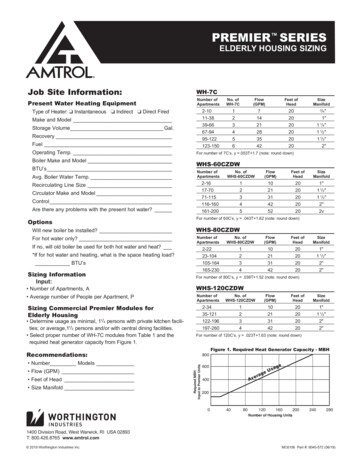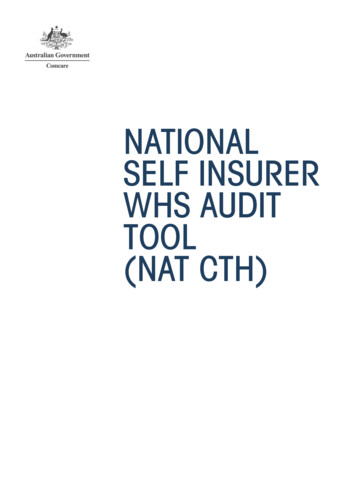
Transcription
NATIONALSELF INSURERWHS AUDITTOOL(NAT CTH)
Version3Release DateSeptember 2014Release StatusEndorsed for usePrepared byComcareConfidentiality CategoryUnrestricted2 WHS 131
CONTENTSINTRODUCTION4WHS management system4Auditing of a WHS management system by regulators4Audits, inspections and legislative compliance5Audits are not designed to assess the performance of individuals5Auditors and audit methodology5Summary5Audit criteria6AUDIT CRITERIA FOR NATIONAL SELF INSURER WHS AUDIT TOOLHOW TO USE THIS AUDIT TOOL716Element 1: Health and Safety Policy1.1Health and Safety Policy1818Element 2: Planning2.1Legal requirements and practical guidance2.2Objectives and targets212126Element 3: Implementation3.1Structure and responsibility—Resources3.2Structure and responsibility—Responsibility and accountability3.3Structure and responsibility—Training and competency3.4Consultation, communication and reporting—Consultation3.5Consultation, communication and reporting—Communication3.6Consultation, communication and reporting—Reporting3.7Documentation3.8Document and data control3.9Health and safety risk management program3.10 Hazard identification, risk assessment and control of risks3.11 Emergency preparedness and response3232343950545864667078103Element 4: Measurement and evaluation4.1Monitoring and measurement—General4.2Monitoring and measurement—Health surveillance4.3Incident investigation, and corrective and preventive action4.4Records and records management4.5Health and safety management system audits112112117118121122Element 5: Management review126APPENDIX128Definition of terms used in this document128Appendix 1: Guide to sampling of audit criteria by topic1333 WHS 131
INTRODUCTIONIn 2005, a multi-jurisdictional working party of regulatory bodies under the Heads of Workers’ Compensation Authorities (HWCA)was formed to develop an occupational health and safety (OHS) audit program and a set of audit guidelines that were agreed ata national level. The National Self-Insurer OHS Audit Tool: User Guide and Workbook was an outcome of that process.The content of this tool was based on Australian Standards AS/NZS 4801 (Occupational health and safety management system—Specification with guidance for use) and AS/NZS 4804 (Occupational health and safety management system—General guidelineson principles, systems and supporting techniques). Other industry-accepted audit tools, including SafetyMAP, the New South WalesSelf Insurance Audit Tool, and the South Australian Performance Standards for Self-Insurers were considered during the developmentof the National Self-Insurer OHS Audit Tool (NAT) version 1. The views of self-insured (licensed) employers and other stakeholderswere also sought and considered. The first Commonwealth jurisdiction version of the National Self Insurer OHS Audit Tool (NAT(Cth)) was developed to reflect the specific requirements of the Occupational Health and Safety Act 1991 (OHS Act). The NAT wasendorsed as the standard OHS audit tool in the Commonwealth jurisdiction in September 2007.In March 2009, at the request of HWCA, a review of the NAT was undertaken by the members of the NAT Review WorkingParty (NRWP), taking into consideration the comments and feedback received from self-insured employers/licensees and otherstakeholders. The outcome of this review is the National Self-Insurer OHS Audit Tool (NAT) version 2.The new Work Health and Safety Act 2011 (WHS Act) came into effect on 1 January 2012; however, due to delays inimplementation in some state jurisdictions, Comcare undertook an interim review of the NAT (Cth) to align it with the new WHSAct. Minor terminology changes resulted in the audit tool, user guide and some criteria being amended or removed to reflect thenew definitions.The purpose of this audit tool is to assess the legislative compliance and effectiveness of a licensee’s health and safety policy andprocedures and its health and safety management systems. It verifies that management systems are in place and evaluates theimplementation and effectiveness of those systems. It is not intended to be used for workplace inspections, nor is it designed toassess the performance of individuals.A second review of the NAT was undertaken during 2013–14 by members of NRWP. Consideration was given to the commentsand feedback from self-insured organisations and other stakeholders. The outcome of the second review is the Nationalself‑insurer WHS management system audit tool (NAT Cth) version 3.WHS MANAGEMENT SYSTEMA PCBU establishing and maintaining an work health and safety management system (WHSMS) shall include organisationalstructure, planning activities, responsibilities, authorities and accountabilities, communications, practices, procedures, processes,and tools and resources for developing, implementing, achieving, reviewing and maintaining the health and safety policy tosafely manage the risks associated with the business practices of the PCBU.AUDITING OF A WHS MANAGEMENT SYSTEM BY REGULATORSBy definition, a WHSMS audit is a systematic examination against defined criteria to determine whether activi-ties and relatedresults comply with planned arrangements, and whether these arrangements are implemented effectively and are suitable toachieve the PCBU’s policy and objectives.The NAT (Cth) defines the criteria that Comcare will use to assess a self-insurers WHSMS.The outcome of an audit is not to provide detailed recommendations for solutions to any identified problems—the purpose is togather objective evidence during an audit to enable the auditor to evaluate conformance or non-conformance (or other ratings asappropriate) against the audit criteria. This provides the PCBU’s management with evidence-based information that can be usedto review the effectiveness of WHSMS and plan change that is designed to deliver continual improvement in managing health andsafety in the workplace.In addition, these audits are designed to assist regulators to make decisions regarding self-insurance requirements.4 WHS 131
AUDITS, INSPECTIONS AND LEGISLATIVE COMPLIANCEA WHSMS audit is separate from a workplace inspection program. Inspections are conducted to detect hazards in the workplaceand to check how well risk controls are working for particular activities, processes or areas. Audits look at the proceduresand processes that are intended to manage the entire health and safety program, rather than the individual deficiencies andfailures identified during inspections. These two activities (audit and inspection) are complementary to each other and are notmutually exclusive.Some of the audit criteria in the NAT (Cth) refer to the requirements of the relevant health and safety legislation, and conformanceto these criteria should indicate that the PCBU has adopted the management practices needed to fulfil its legal responsibilities.However, conformance to the audit criteria alone does not assure compliance with all statutory obligations, nor does it precludeany action by a regulatory body.AUDITS ARE NOT DESIGNED TO ASSESS THE PERFORMANCE OFINDIVIDUALSAudits of a WHSMS should assess how effectively the system, including its structure, policies, planning activities, resourcing,operating procedures, and work practices combine together to manage the risks asso-ciated with the PCBU’s business. Audits arenot designed to measure the performance of individuals work-ing within the system.AUDITORS AND AUDIT METHODOLOGYWHSMS audits undertaken for the purpose of assisting Comcare to make decisions regarding self-insurance are conducted byauditors who are appropriately qualified and experienced in system auditing. Various au-dit training and certification programsare available to ensure that they have the required competency and experience for this work.The audit approach underpinning the NAT (Cth) is consistent with the comprehensive auditing methodology provided in AS/NZSISO 19011: Guidelines for quality and/or environmental management systems auditing.SUMMARYThis audit tool has been designed to assist Comcare with the conduct of audits using the NAT (Cth) to understand and apply theaudit criteria in a consistent manner.The NAT (Cth) may also be used by self-insurers when undertaking self-audits to help them prepare and monitor theirperformance against the same criteria used by the regulators.The following pages define the audit criteria, provide further information about the criteria to assist with interpretation andunderstanding, and offer guidance to auditors and users to improve the efficiency and effectiveness of audit activities.5 WHS 131
AUDIT CRITERIAThis tool comprises 108 criteria combined into five elements as listed below.Element 1—Health and Safety Policy (3 criteria)A meaningful health and safety policy depends on commitment from management and effective consultation with workers. Thehealth and safety policy must clearly set out the intentions of the person conducting a business or undertaking (PCBU) withrespect to continuous improvement of health and safety.Element 2—Planning (11 criteria)A health and safety management plan must outline specific strategies for managing the risks associated with all hazardsidentified in the workplace. Relevant health and safety legislation and information must be readily available. Criteria groupsaddressed by this element include: legal requirements and practical guidance objectives and targets health and safety management plans.Element 3—Implementation (79 criteria)Health and safety must be integrated into the management of all work activities. There should be a systematic process forthe development of work methods that minimise health and safety risks. Hazardous operations or locations should be strictlycontrolled and plant and equipment should be regularly inspected and serviced. Consultation and training are key factors in thesuccessful operation of a health and safety management system. Criteria groups addressed by this element include: structure and responsibility—resources, responsibility and accountability, and training and competency consultation, communication and reporting documentation document and data control health and safety risk management program hazard identification, risk assessment and control of risks emergency preparedness and response.Element 4—Measurement and evaluation (13 criteria)It is necessary for a PCBU to monitor the workplace to gather information about potential hazards and to have processes inplace to act on the information obtained. Where hazards are identified and accidents or incidents occur, it is crucial that they arereported and a suitable investigation is carried out. Criteria groups addressed by this element include: monitoring and measurement—general and health surveillance incident investigation, corrective and preventive action records and records management health and safety management system audits.Element 5—Management review (2 criteria)Senior management has a responsibility to ensure that the systems in place continue to meet the needs of the PCBU. This canonly be successful if the management system is reviewed on an ongoing basis. Areas identified as deficient need to be actioned.The process of management review must ensure that recommendations are documented for corrective action.6 WHS 131
AUDIT CRITERIA FOR NATIONAL SELF INSURER WHSAUDIT TOOLELEMENT 1: HEALTH AND SAFETY POLICY1.1 Policy1.1.1Senior management in consultation with all workers and/or their representatives shall define and documentits policy for, and commitment to, health and safety. The policy shall be endorsed and supported by the mostsenior person within the PCBU, for example, the Chief Executive Officer or Managing Director. The health andsafety policy shall be developed consistent with relevant legislative requirements and include a commitmentto:a. the risk management process and ensure consistency with the nature of workplace activities and scale ofhealth and safety risksb. comply with relevant health and safety legislation and other requirements placed upon the PCBU or towhich the PCBU subscribesc. establish measurable objectives and targets for health and safety to ensure continuous improvementaimed at elimination of work-related illness and injuryd. the provision of appropriate health and safety training to all workerse. the consultation process to ensure all workers are included in the decision making where there is animpact on workplace health and safetyf.the dissemination of health and safety information to all workers and visitors to the workplaceg. effective implementation of the health and safety policy.1.1.2The health and safety policy is available to other interested parties, including regulatory authorities, suppliers,contractors, and those visiting the workplace.1.1.3The health and safety policy is maintained and reviewed periodically to ensure it remains relevant andappropriate to the PCBU’s health and safety risks.ELEMENT 2: PLANNING2.1 Legal requirements and practical guidance2.1.1The PCBU identifies and monitors the content of all health and safety legislation, standards, codes of practice,agreements and guidelines relevant to its operation.2.1.2The PCBU’s procedures, work instructions and work practices reflect the requirements of current health andsafety legislation, standards, codes of practice, agreements and guidelines.2.1.3Relevant workers in the PCBU are advised of, and have ready access to, current relevant health and safetylegislation, standards, codes of practice, agreements and guidelines.7 WHS 131
2.1.4The PCBU and/or individual satisfies legal requirements to undertake specific activities, perform work oroperate equipment including any:a. licenceb. certificate of competencyc. notificationd. registratione. approval or exemptionf.2.1.5other relevant requirements.Changes to health and safety legislation, standards, codes of practice, agreements and guidelines generate areview of existing procedures.2.2 Objectives and targets2.2.1Health and safety objectives and targets consistent with the PCBU’s health and safety policy are documented,are appropriate to the PCBU’s activities and consider:a. legal requirementsb. standards, codes and guidelinesc. health and safety hazards and risksd. past health and safety performance (as defined by the PCBU’s system requirements)e. technological developmentsf.leadership and worker participation.2.2.2Specific health and safety objectives and measurable targets have been assigned to all relevant functions andlevels within the PCBU.2.2.3The PCBU sets health and safety performance indicators that are consistent with its objectives and targets.2.3 Health and safety management plans2.3.1In addition to defining the means by which the PCBU will achieve its objectives and targets, the health andsafety management plan(s):a. responds to legal requirementsb. is based on an analysis of information relevant to the nature of the PCBU’s activities, processes, productsor servicesc. takes account of identified hazards and health and safety management system failuresd. aims to eliminate or reduce workplace illness and injurye. defines the PCBU’s prioritiesf.sets timeframesg. allocates responsibility for achieving objectives and targets to relevant functional levelsh. states how the plan will be monitored.2.3.2The PCBU monitors its progress towards meeting the objectives and targets set in the health and safetymanagement plan and takes corrective actions to ensure progress is maintained.2.3.3Health and safety management plans are reviewed on a regular basis, to ensure they are kept up-to-date, andwhen there are changes to the PCBU’s activities, processes, products or services.8 WHS 131
ELEMENT 3: IMPLEMENTATION3.1 Structure and responsibility–Resources3.1.1Financial and physical resources have been identified, allocated and are periodically reviewed, to enable theeffective implementation of the PCBU’s health and safety management system.3.1.2There are sufficient qualified and competent persons to implement the PCBU’s health and safety managementsystem as identified through a documented review.3.2 Structure and responsibility—Responsibility and accountability3.2.1Senior management understand the PCBU’s legal obligations for health and safety and can demonstrate howthey fulfil them.3.2.2A member of senior management or the board of directors has been allocated overall responsibility for thehealth and safety management system and reports to that group on its performance.3.2.3The specific health and safety responsibilities (including legislative obligations), authority to act and reportingrelationships in the PCBU have been defined, documented and communicated.3.2.4Where contractors (workers) are utilised in the PCBU, the health and safety responsibilities andaccountabilities of the PCBU and the contractor(s) have been clearly defined, allocated and communicatedwithin the PCBU and to the contractor(s) and their workers.3.2.5Workers are held accountable for health and safety performance in accordance with their definedresponsibilities.3.3 Structure and responsibility—Training and competency3.3.1The PCBU has a procedure for identifying and defining the health and safety training needs of workers.3.3.2The PCBU consults with workers to identify their training needs in relation to performing their workactivities safely.3.3.3A documented training plan(s) based on training needs shall be developed and implemented.3.3.4The PCBU trains workers (as appropriate) to perform their work safely, and verifies their understanding ofthat training.3.3.5The PCBU has an induction program for all workers including management, which is based on their likely riskexposure, and provides relevant instruction in the PCBU’s health and safety policy and procedures.3.3.6Training and assessment is delivered by competent persons with appropriate knowledge, skills andexperience.3.3.7The specific requirements of tasks are identified, applied to the recruitment and placement of workers, andtasks are allocated according to their capability and level of training.3.3.8Management has received training in health and safety management principles and practices appropriate totheir role and responsibilities within the PCBU, and the relevant health and safety legislation.3.3.9Those representing the PCBU and the workers on health and safety matters, including representatives onconsultative committee(s) receive appropriate training to enable them to undertake their duties effectively.9 WHS 131
3.3.10Refresher training (as identified by training needs) is provided to all workers to enable them to perform theirtasks safely.3.3.11The training program is reviewed on a regular basis, and when there are changes in the workplace thatimpact on the health and safety of workers, to ensure that the skills and competencies of workers remainrelevant.3.4 Consultation, communication and reporting—Consultation3.4.1There are procedures agreed to by workers outlining their involvement and consultation in:a. health and safety mattersb. health and safety issuesc. any proposed changes to the work environment, processes, practices or purchasing decisions that impacton their health and safety.3.4.2The PCBU has:a. in consultation with workers, determined the number of worker representatives required to effectivelyrepresent all work groupsb. made arrangements to allow the workers to select those who will represent them on health and safetymatters consistent with legislative requirementsc. communicated the consultative arrangements to workers, including names of their worker and employerrepresentatives for health and safety matters.3.4.3Those who represent workers on health and safety matters:a. are provided time and resources to effectively undertake this roleb. meet regularly with management about health and safety issues and the minutes of their meetings areavailable to all workers.3.4.4Workers or their representatives are involved in the development, implementation and review of procedures forthe identification of hazards and the assessment and control of risks.3.5 Consultation, communication and reporting—Communication3.5.1The PCBU’s health and safety policy and other relevant information on health and safety are communicated toall workers, and consider language and standards of literacy.3.5.2The PCBU regularly communicates to workers about the progress towards the resolution of health and safetydisputes.3.5.3There are procedures for exchange of relevant health and safety information with external parties, includingcustomers, suppliers, contractors and relevant public authorities.3.5.4There is a procedure that encompasses health and safety issues for dealing with formal and informalcomplaints received from external parties.3.6 Consultation, communication and reporting—Reporting3.6.1Workplace injuries and illnesses, incidents, health and safety hazards, dangerous incidents and systemsfailures are reported and recorded in accordance with relevant procedures.3.6.2Where there is a legislative requirement, injuries, illnesses, incidents and dangerous incidents are notified tothe appropriate authorities within the stipulated timeframes.3.6.3Reports on health and safety inspections, testing and monitoring, including recommendations for correctiveaction, are produced and forwarded to senior management and worker representative(s) as appropriate.10 WHS 131
3.6.4Regular, timely reports on health and safety performance, including reports against health and safetyobjectives, targets and management plans are produced and distributed within the PCBU.3.6.5Reports of audits and reviews of the health and safety management system are produced and distributedwithin the PCBU.3.6.6The PCBU’s annual report or an equivalent document includes information about health and safetyperformance.3.7 Documentation3.7.1The PCBU’s health and safety policy, plans and procedures are documented in a planned and organisedmanner.3.7.2Specific instructions and safe work procedures associated with particular products, processes, projects orsites have been developed where appropriate.3.8 Document and data control3.8.1The PCBU has a system for creating, modifying and approving health and safety documents and data, andnotifying relevant persons of any changes. Obsolete documents and data are identified and retained (whererequired) for legal and/or knowledge preservation purposes and are removed from all points to preventunintended use.3.8.2Documents and data critical to health and safety shall be clearly identifiable, duly authorised prior to issue,kept legible and include their issue status.3.8.3The PCBU provides workers with ready access to relevant health and safety documents and data and advisesthem of its availability.3.8.4Documents and data are regularly reviewed by competent persons to ensure their effectiveness, suitability andthe currency of the information.3.9 Health and safety hazard management program3.9.1The PCBU documents its methodology to reduce health and safety risks through hazard identification, riskassessment and development of risk control measures in accordance with the hierarchy of controls and legalrequirements.3.9.2The PCBU has identified the hazards, including public safety hazards that are associated with its activities,processes, products or services, assessed the risks involved, and implemented suitable control measures inaccordance with the PCBU’s methodology.3.9.3The hazard identification, risk assessment and risk control process is undertaken by persons competent in theuse of the PCBU’s methodology.3.9.4The PCBU documents all identified hazards, risk assessments and risk control plans.3.9.5Risks of identified hazards are assessed in consultation with workers having regard to the likelihood andconsequence of injury, illness or incidents occurring, taking into consideration:a. legal requirementsb. evaluation of available informationc. records of incidents, illness and diseased. the potential for emergency situations.11 WHS 131
3.9.6The level of risk is assessed and used to prioritise the implementation of risk control measures.3.9.7Hazard management methodology and associated procedures shall be reviewed and revised where necessaryto ensure relevance, adequacy and compliance with health and safety management system requirements.3.9.8The PCBU has a program for identifying and managing change that may impact on health and safety.3.10 Hazard identification, risk assessment and control of risks3.10.1The PCBU determines those areas where access controls are required and ensures effective controls areimplemented and maintained.3.10.2Health and safety requirements are identified, evaluated and incorporated into all purchasing specifications forservices.3.10.3The ability to meet health and safety requirements is assessed in the selection of contractors and labour hireworkers (workers).3.10.4Temporary workers health and safety performance is monitored and reviewed to ensure continued adherenceto the PCBU’s health and safety requirements or specifications.3.10.5The PCBU determines their health and safety requirements prior to the purchase of goods, and communicatesthose specifications to the supplier.3.10.6Procedures shall be established and implemented for verifying that purchased goods meet health and safetyrequirements and address discrepancies before the goods are put into operational use.3.10.7Hazard identification, risk assessment and the development of control measures are undertaken during thedesign stage of plant, products, buildings or processes, or when the design is modified.3.10.8Competent persons verify that designs and modifications meet specified health and safety requirements.3.10.9There are procedures to ensure that materials and substances are disposed of in a manner that minimises riskof personal injury and illness.3.10.10 Facilities and amenities in the workplace conform, as a minimum, to relevant legislation, standards andcodes of practice.3.10.11 The PCBU has a program for the safe use, handling, transfer, inventory management and transport ofhazardous chemicals.3.10.12 Comprehensive health and safety information on all hazardous chemicals is readily accessible.3.10.13 The PCBU ensures that hazardous chemicals are stored safely and in accordance with legislativerequirements.3.10.14 The PCBU has permit to work procedures for use when required.3.10.15 Where personal protective equipment is required—it is appropriate for the task, its provision is accompaniedby suitable training or instruction, and it is used correctly and maintained in a serviceable condition.3.10.16 Plant and equipment is maintained to ensure safe operational use and a record is kept which includes (but isnot limited to) relevant details of inspections, maintenance, repair and alteration of plant.3.10.17 There is a procedure for unsafe plant and equipment to be identified and quarantined or withdrawn fromservice.3.10.18 Controls are implemented to ensure the safety of persons (including members of the public) whilst plant andequipment is in the process of being cleaned, serviced, repaired or altered.12 WHS 131
3.10.19 Competent persons verify that plant and equipment is safe before being returned to service after repair oralteration.3.10.20 Safety signs, including regulatory, hazard, emergency information and fire signs, meet relevant standards andcodes of practice, and are displayed in accordance with legal and organisational requirements.3.10.21 There are procedures to ensure that materials are transported, handled and stored in a safe manner.3.10.22 Workers are supervised according to their capabilities and the degree of risk of the task they are undertaking,to ensure that tasks are performed safely and work instructions and procedures are followed.3.10.23 The PCBU has a program to effectively manage the safety of workers when working at workplaces not underthe control of the PCBU.3.10.24 Customer-supplied goods and services used in the PCBU’s work processes are subject to hazardidentification, risk assessment and control prior to use.3.10.25 All substances in containers and transfer systems are identified and clearly labelled to avoid inadvertent orinappropriate use.3.11 Emergency preparedness and response3.11.1Potential emergency situations have been identified and an emergency plan is:a. developed for the PCBU and its workplaceb. in accordance with legislative requirementsc. regularly reviewed.3.11.2The PCBU has allocated overall responsibility for control of emergency situations to specified individuals andcommunicated this information to all workers.3.11.3Workers receive training and practice in the emergency plan appropriate to their allocated emergencyresponse requirements.3.11.4Competent persons have periodically assessed the suitability, location and accessibility of emergencyequipment.3.11.5Emergency and fire protection equipment, exit signs and alarm systems are regularly inspected, tested,and maintained, and suitability, location and accessibility are reviewed if there has been a change in theworkplace.3.11.6The PCBU ensures that a system is in place to inform relevant emergency authorities of the hazards (includinghazardous chemicals), and on attendance during an emergency.3.11.7The PCBU has assessed its first aid requirements and the first aid program is in place.3.11.8The PCBU has procedures to assist workers who are exposed to critical incidents at work.ELEMENT 4: MEASUREMENT AND EVALUATION4.1 Monitoring and measurement—General4.1.1There is a health and safety inspection, testing and monitoring program that incorporates timely and effectivecorrective action processes.4.1.2Inspections seek input and involvement from the workers who are required to undertake the tasks beinginspected.13 WHS 131
4.1.3Engineering controls, including safety devices, are regularly inspected and tested (where appropriate) toensure their int
Act. Minor terminology changes resulted in the audit tool, user guide and some criteria being amended or removed to reflect the new definitions. The purpose of this audit tool is to assess the legislative compliance and effectiveness of a licensee's health and safety policy and procedures and its health and safety management systems.
